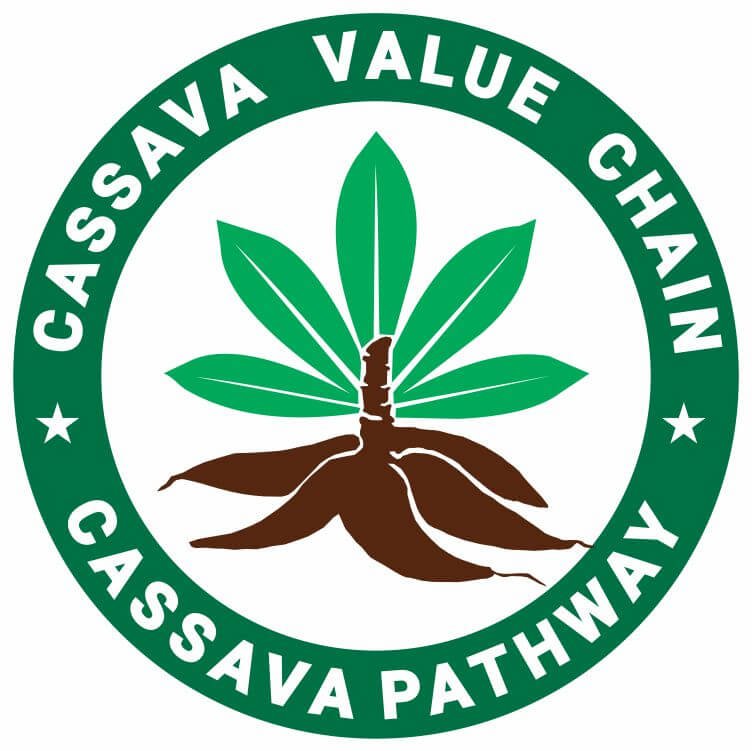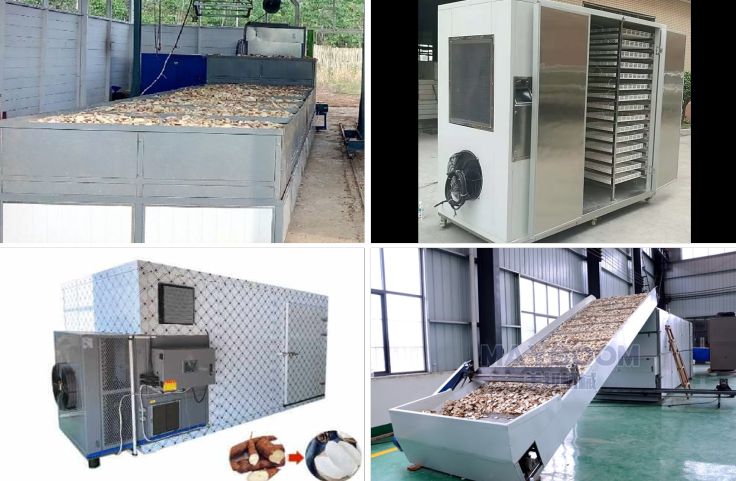Cassava dryer machine boosts efficiency and product quality by using the right type, getting the benefits, and choosing the best one for your processing needs.
You already know how much time and effort drying can take if you are a cassava processor.
Sun drying might be cheap, but it’s unreliable and leaves too much to chance.
Rainfall, pests, and uneven drying can ruin batches and slow down production.
This is where cassava dryer machines come in. They give you more control over your process, reduce spoilage, and help you meet higher quality standards.
With better moisture control and faster turnaround, you can scale operations and meet market demands with less waste.
Whether you’re producing flour, starch, or animal feed, choosing the right drying method makes a big difference.
If you’re tired of delays and losses, it’s time to rethink how you dry your cassava.
Let’s look at how these machines work, their types, and how to choose one that fits your needs.
New to cassava processing? Start here.
Table of Contents
- What is a Cassava Dryer Machine?
- Importance of Drying in Cassava Processing
- Types of Cassava Dryer Machines and How They Work
- Features to Look for in a Cassava Dryer Machine
- Benefits of Using a Cassava Dryer Machine
- Factors to Consider Before Buying a Cassava Dryer Machine
- Cassava Dryer Machine Price Guide
- Where to Buy Cassava Dryer Machines
- Maintenance and Safety Tips
- Case Study Summary: Greenfield Farms’ Cassava Dryer Success
- Frequently Asked Questions About Cassava Dryer Machines
- Conclusion
What is a Cassava Dryer Machine?
A cassava dryer machine is specialized equipment used to remove moisture from cassava efficiently through controlled heat and airflow.
Unlike traditional sun drying, which depends on weather and can result in uneven drying or contamination, this machine ensures uniform moisture reduction in a hygienic environment.
It helps preserve the nutritional content, texture, and quality of cassava while significantly reducing drying time.
Cassava dryers come in various models and sizes, suitable for both small-scale and industrial processing.
By providing consistent results and minimizing spoilage, the machine supports higher productivity and helps meet the standards required for commercial cassava-based products.
Related: Cassava Dewatering Machine Guide
Importance of Drying in Cassava Processing
Drying helps protect your cassava from spoilage and makes it ready for long-term storage or sale.
If you want high-quality cassava products, drying is a step you can’t skip.
Prevents Spoilage and Preserves Quality
When you dry cassava properly, you remove the moisture that mold and bacteria need to grow.
This keeps your crop safe from contamination and protects its nutritional content.
Moist cassava spoils quickly, especially in humid environments, and poor drying can ruin an entire harvest.
With good drying practices, your cassava stays fresh, clean, and ready for storage or further processing.
This step lays the foundation for a safe and valuable final product.
Supports Cassava Flour, Starch, Chips, and Feed Production
Dried cassava opens the door to a wide range of products.
You can turn it into flour for baking, starch for food and industrial use, chips for snacks, or feed for animals.
Each product requires well-dried cassava to maintain quality during processing.
If the cassava holds too much moisture, it can affect texture, shelf life, and safety.
Drying makes your cassava flexible for various uses without compromising quality or usability.
Improves Storage and Inventory Control
Dry cassava can sit in storage for months without going bad.
That means you don’t have to sell or process everything right away.
You get time to plan, manage your inventory, and meet demand even during the off-season.
By reducing the water content, drying helps you avoid losses and delays.
It gives you control over when and how to sell or use your cassava products without being rushed by spoilage.
Helps You Meet Market Standards and Boost Income
Markets expect dried cassava to meet specific quality and moisture levels.
If you get it right, you can earn more and reach better-paying buyers. Poorly dried cassava lowers your price and limits where you can sell.
Proper drying helps you meet industry requirements and gives your products the consistency buyers want.
This puts you in a stronger position to compete locally and internationally, opening up more profitable opportunities.
Related Posts
Guide to Cassava Peeling Machine
Multi-Function Cassava Processing Units
5 Cassava Processing Machines for Small Businesses
How to Peel Cassava Root the Right Way
Top Manufacturers of Cassava Processing Equipment
Guide to Cassava Grater Machine
How a cassava sieving machine fits into the full cassava processing line
Types of Cassava Dryer Machines and How They Work
Cassava dryer machines help you dry cassava faster, cleaner, and more consistently than sun drying.
Each type works differently, and the best choice depends on your production size and goals.
Flash Dryer: Fast Results for Large Batches

If you’re dealing with large volumes of cassava chips, flash dryers might be your best option.
They use a strong flow of hot air to remove moisture quickly.
This rapid drying method helps prevent spoilage and is useful for commercial processors looking for speed and efficiency.
You can dry a lot of cassava in a short time, which reduces turnaround and keeps your operation moving.
Although the initial cost is higher, the speed and capacity can justify the investment for high-output systems.
Flash dryers are ideal for processors aiming to scale up cassava flour or starch production.
How it works
Flash dryers blow high-temperature air through a drying duct where fine cassava particles are suspended in motion.
The heat rapidly pulls out moisture while the air keeps the particles from sticking or burning.
The process lasts just seconds, and the dried product is then separated from the airflow using a cyclone separator.
The result is fast, uniform drying with minimal manual handling and consistent product quality. See an in-depth post on the cassava industrial flash dryer.
Tray Dryer: Simpler Setup with Reliable Results
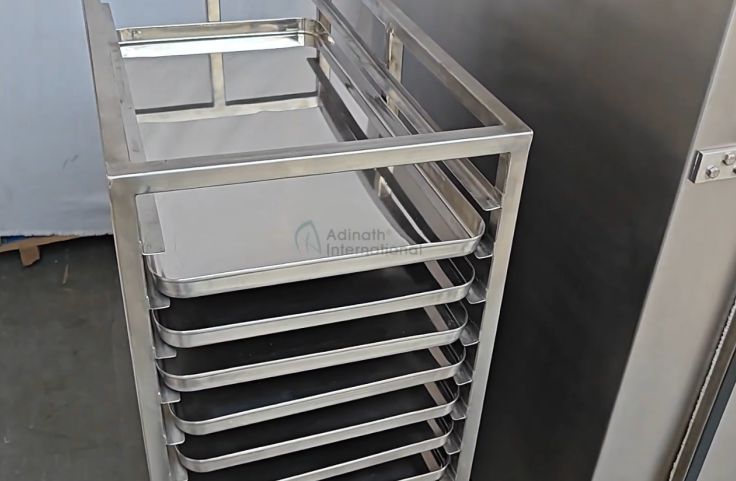
Tray dryers work well for small to medium processors.
You place sliced cassava on trays inside a chamber where heated air circulates to remove moisture.
The process takes longer than flash drying, but it’s more affordable and easier to maintain.
You control the heat and time, so you get consistent drying without complex equipment.
This method is good for producers who prioritize energy savings and want hands-on control.
Tray dryers are dependable for low-scale operations, especially when drying cassava for flour, chips, or small-volume starch production.
How it works
The sliced cassava is loaded onto trays, which are inserted into a drying cabinet or chamber.
A heating unit raises the air temperature, and a fan circulates the hot air across the trays.
As air passes over and through the cassava, it absorbs moisture, which is then vented out.
The drying temperature and time can be manually adjusted depending on the thickness and initial moisture of the cassava.
This slower method offers more control and better product appearance.
Rotary Dryer: High Throughput with Continuous Drying
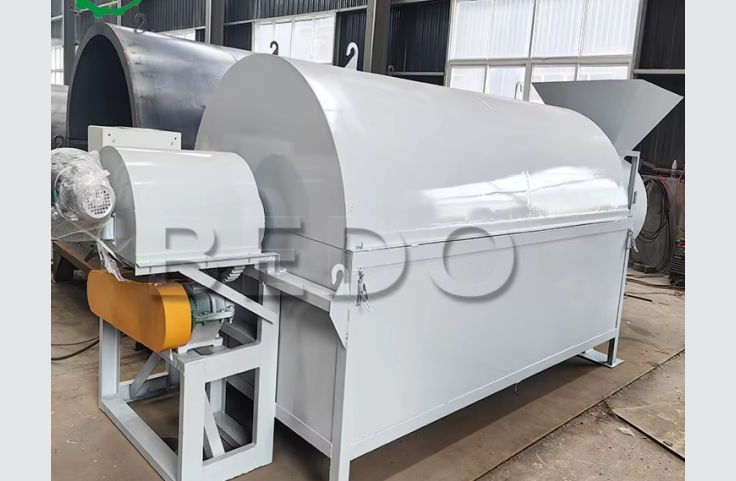
A rotary dryer helps when you need non-stop drying with big volumes of cassava.
The machine’s drum rotates continuously, which spreads the cassava evenly while applying heat.
It’s a strong choice for industrial-scale operations aiming for efficiency and speed.
You’ll need to account for the energy usage and regular maintenance, but the steady output can support high-demand processing.
Rotary dryers are good for businesses focused on large-scale starch or feed production where consistent drying and round-the-clock operations matter.
How it works
Wet cassava enters a large rotating drum through a feeder.
As the drum turns, internal lifters move the cassava through heated air that flows either in the same or opposite direction.
The tumbling motion ensures even exposure to heat.
Moisture evaporates steadily as the cassava moves from one end of the drum to the other.
Dried material exits at the discharge point, while exhaust systems vent out humid air. It’s continuous, hands-off, and reliable.
Cabinet Dryer: Controlled Drying for Smaller Loads
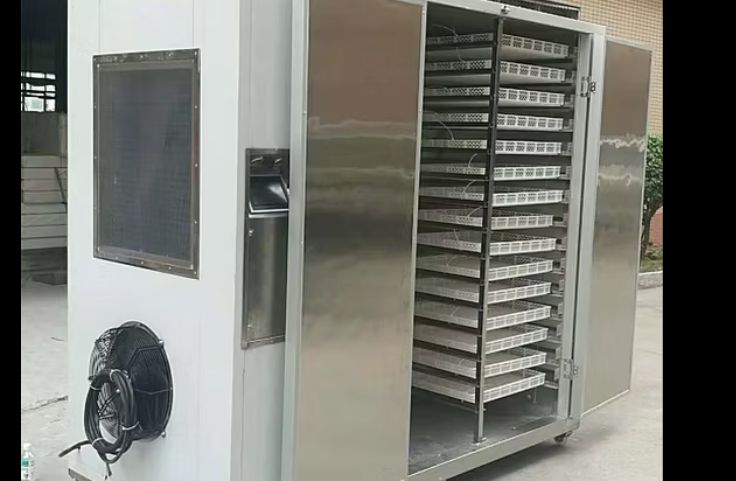
Cabinet dryers are a smart pick if you’re processing smaller batches of cassava and want tighter control over temperature and timing.
These machines come with enclosed compartments that help preserve the quality and color of the cassava.
They’re often used by processors focused on specialized products where uniform drying is key.
While the output is lower compared to other machines, the consistency and product safety are worth it if you’re working on niche markets or limited production runs.
How it works
You load cassava slices into trays and place them inside a sealed cabinet.
Heated air, generated by electric or gas elements, flows through built-in ducts and circulates evenly using fans.
Temperature and drying time are set manually or digitally, giving you full control.
Moisture is extracted gradually and vented outside. Because the space is enclosed, the cassava is protected from contaminants.
This method is ideal for preserving color, texture, and flavor in smaller, high-value batches.
Belt Dryer: Steady Automation for Medium to Large Scale

Belt dryers use a moving conveyor system to pass cassava through different heated sections.
This setup is ideal for operations that need both volume and consistency.
The process is mostly automated, which means fewer hands-on tasks and more output.
You’ll get uniform drying and better workflow, especially if you plan to produce cassava starch or chips regularly.
Although the cost to set up is higher, belt dryers pay off by saving time and boosting daily output with minimal interruptions.
How it works
Sliced cassava is placed on a perforated conveyor belt.
As the belt moves slowly through heated chambers, hot air flows above and below the cassava.
Each zone may have different temperatures, starting high to quickly remove surface moisture and finishing low for deep drying.
The continuous motion keeps output steady, and automation reduces manual work.
Moisture is carried out through vents, while the dried cassava exits at the end for cooling and packing.
This setup ensures efficiency and quality across each batch.
Features to Look for in a Cassava Dryer Machine
Choosing the right cassava dryer machine can make your work easier and your processing more efficient.
Here are the key features you should consider before making a decision.
Drying Capacity: Match Your Output Goals
Choose a cassava dryer that matches how much you process daily.
Small operations need less capacity, while larger setups require machines that handle more to avoid delays and keep production steady.
Energy Source: Choose What Works for You
Select an energy source that fits your location and budget.
Solar works well in sunny areas, electric for reliable power, and biomass if you have farm waste or firewood nearby.
Temperature Control: Keep Drying Even and Consistent
Look for a dryer with adjustable temperature settings.
This helps you dry cassava evenly, reduce spoilage, and keep quality consistent across every batch, no matter the moisture level.
Material Build: Look for Strength and Durability
Go for a cassava dryer made with strong, rust-resistant materials.
It will last longer, handle frequent use, and save you from constant repairs, especially in humid environments or heavy processing seasons.
Portability: Make Movement Easier
If you need flexibility, choose a portable dryer with wheels or handles.
This helps you move it around easily, especially if you share equipment or dry cassava in different locations.
Easy Maintenance: Save Time and Avoid Downtime
Pick a machine that’s simple to clean and service. Easy access to parts means less downtime and faster fixes.
You’ll spend more time drying cassava and less time fixing equipment.
Benefits of Using a Cassava Dryer Machine
Using a cassava dryer machine can change the way you handle cassava.
It helps you work faster, cut losses, and improve product quality more consistently and reliably.
Faster Drying Saves You Time
Cassava dryer machines speed up your production by cutting drying time from days to hours.
This helps you meet demand faster, avoid delays during peak harvest, and reduce spoilage risks.
Faster turnaround keeps your operation steady, improves efficiency, and helps you keep up with growing orders without missing deadlines.
Better Product Quality and Hygiene
With a cassava dryer, you reduce contact with dust, pests, and moisture.
The controlled drying environment keeps your cassava clean and safe for consumption.
Consistent heat preserves taste and nutrients. Your final product meets food safety standards, looks better, and lasts longer on the shelf or in storage.
Works in Any Weather
A cassava dryer keeps your work going rain or shine. You don’t have to wait for clear skies or risk losses from unexpected weather changes.
This means more consistent output and better planning.
You can run your operation without disruptions and maintain your drying schedule all year round.
Cuts Down Labor Costs
Drying manually takes time and effort, but a cassava dryer handles most of the work.
You’ll need fewer workers, which cuts labor costs and saves time.
Your team can focus on other tasks, like sorting and packing.
It’s a smart way to improve productivity while managing your budget.
Grows With Your Business
Cassava dryers come in sizes that match your needs. As your processing grows, you can upgrade or scale up without starting from scratch.
You stay ready for more demand without sacrificing speed or quality.
A flexible machine setup supports both small producers and large commercial operations as they expand.
Factors to Consider Before Buying a Cassava Dryer Machine
Before you buy a cassava dryer machine, it’s smart to think through a few important points.
The right machine can save time, reduce waste, and help your processing run smoothly.
Scale of Operation: Know Your Output Size
Choose a cassava dryer based on how much you process daily.
Smaller setups need basic machines, while larger operations require higher capacity to avoid delays and keep production steady without overworking the equipment.
Type of Cassava Product: Match the Machine to the Output
Different cassava products require different drying methods.
Pick a machine that suits your end product, whether it’s flour, chips, or feed, to ensure proper texture, faster drying, and better quality in every batch.
Budget and Long-Term Value: Spend Smart
Look beyond the initial cost. Factor in maintenance, repairs, and energy use.
A cheaper machine may lead to higher long-term expenses, while a durable, efficient model provides better performance and long-term value.
Energy Use: Keep Running Costs in Check
An energy-efficient cassava dryer saves money over time. Choose a model that uses less fuel or power but still dries evenly.
This keeps daily running costs low and improves your overall processing efficiency.
Maintenance and Local Support: Think Long-Term
Easy access to spare parts and local repair services helps you avoid long downtimes.
A machine that’s simple to maintain and backed by local support keeps your operations steady and less stressful.
Cassava Dryer Machine Price Guide
If you’re planning to invest in a cassava dryer machine, understanding the pricing helps you make a smart choice.
Let’s break down the costs based on your production needs and machine features.
Entry-Level Cassava Dryers: Good for Small-Scale Use
If you’re running a small farm or just starting cassava processing, you’ll find basic dryers priced between $2,000 and $5,000.
These include solar dryers or manually operated models.
They may not dry large batches quickly, but they help you get started with minimal investment.
For many small-scale processors, this range works well because it keeps costs low while still improving output and reducing spoilage compared to sun drying.
Mid-Range Machines: Faster Drying and Higher Capacity
For growing farms or cooperatives, mid-range cassava dryers offer more speed and volume.
These mechanical or hybrid models usually cost between $5,000 and $15,000.
You’ll dry more cassava in less time, which means better productivity.
The higher price reflects better components, stronger build quality, and sometimes extra features like temperature control or adjustable airflow.
This range gives you a good balance of cost and performance if you’re ready to move beyond basic equipment.
Industrial-Grade Dryers: High Output for Commercial Use
If you’re processing cassava on a large scale or supplying big markets, you may need to consider industrial dryers.
These machines are built for heavy-duty work and automation.
Prices can start at $15,000 and reach over $25,000, depending on size and features.
While they require a larger investment, they pay off with consistent drying, faster output, and lower manual labor costs.
This option works best for commercial producers or cassava processing businesses with steady demand.
Installation and Transport: Plan for Extra Costs
When budgeting, include the cost of installation and transport. Installation can range from $500 to $3,000, depending on the machine and location.
Larger dryers might need specialized transport and handling, which can add more.
These extra costs are easy to overlook, but planning for them helps avoid surprises and keeps your purchase within budget.
Ask suppliers about what’s included so you can prepare ahead of time.
Operational Costs: Don’t Forget the Running Budget
Beyond buying the machine, think about what it takes to keep it running.
Power supply, fuel, maintenance, and occasional repairs will affect your long-term budget.
Machines that use less energy may cost more upfront, but save you money over time.
Regular maintenance keeps your dryer efficient and avoids costly breakdowns.
Include these factors in your planning so your cassava processing stays reliable and profitable.
Choose Based on Your Needs and Budget
You don’t need the most expensive dryer to run a successful cassava operation.
Choose based on your scale, product goals, and available resources.
Talk to different suppliers, compare prices, and check what each model offers.
A machine that fits your budget and meets your daily needs will support steady growth without putting too much pressure on your finances. Start where you are and grow from there.
Where to Buy Cassava Dryer Machines
Finding the right place to buy a cassava dryer machine can save you time, money, and stress.
Your focus should be on trusted sources that offer reliable equipment and good support.
Trusted Brands: Start With Known Names
When you’re ready to buy, look for manufacturers with a strong reputation in agricultural machinery.
Brands that have been around for a while and consistently produce dependable cassava dryers are usually safer choices.
Check for industry certifications or memberships that show their credibility.
A well-known name gives you peace of mind that the equipment has been tested and trusted by other cassava processors like you.
Warranty and Support: Check What Comes After the Sale
Before buying, make sure the machine comes with a solid warranty.
A good warranty protects you in case of faults and shows that the manufacturer stands by their product.
Also, find out if they offer after-sales support like repairs, spare parts, or maintenance help.
This matters more than you might think, especially when your machine needs quick servicing to keep operations going.
Reviews and Testimonials: Learn From Other Buyers
Reading what other buyers say can help you avoid mistakes.
Look for reviews that mention how well the dryer works, how long it lasts, and how the supplier handles customer service.
If possible, ask the supplier for contact information of past buyers or examples of businesses they’ve worked with.
Real feedback gives you better insight than a polished product brochure ever will.
Local Suppliers: Convenience and Quick Access
Buying locally has its benefits. You can inspect the machine before paying, talk directly with the seller, and get quicker help if something goes wrong.
Local suppliers are often easier to reach for troubleshooting or technical support.
This saves time and keeps your drying process on track with fewer interruptions.
International Options: More Choices and Features
If local options don’t meet your needs, consider international suppliers.
Many global manufacturers offer a wider range of cassava dryer machines with different features and capacities.
You might find better deals or more advanced models this way. Just make sure to factor in shipping, customs, and possible delays.
Work with exporters who have experience shipping agricultural equipment to your region.
Online Marketplaces: Compare Quickly and Easily
Websites like Alibaba, Made-in-China, and even Amazon carry cassava dryers from various manufacturers.
These platforms let you compare prices, read reviews, and view photos or videos before making a decision.
While online shopping offers convenience and variety, double-check product details and seller ratings before committing.
When buying online, communication with the seller is key to making sure the machine fits your needs.
See a dedicated post on cassava processing equipment manufacturers.
Maintenance and Safety Tips
Taking care of your cassava dryer machine keeps it working smoothly and helps avoid costly repairs.
A few simple habits can make a big difference in how long your machine lasts.
Cleaning: Remove Buildup Before It Slows You Down
After each major use, take time to clean the dryer. Cassava residue, dust, and bits of fiber can clog airflow or stick to hot parts.
Wipe down surfaces with a soft cloth and brush out tight areas.
Leaving dirt to build up can reduce drying efficiency and even cause contamination.
Stay ahead of the mess by setting a regular cleaning schedule that fits how often you use the machine.
Lubrication: Keep Moving Parts Running Smooth
Gears, belts, and bearings need regular attention. Check these parts every few weeks and add lubricant where needed, following your machine’s manual.
Skipping this step can lead to grinding, noise, and breakdowns.
Make sure you’re using the right type of oil or grease, as the wrong one can damage parts instead of protecting them.
Smooth parts mean smoother production and fewer surprises.
Temperature Monitoring: Stay in the Right Range
Keep a close eye on the heat settings. Drying cassava evenly means holding the temperature steady throughout the process.
Use built-in sensors or external thermometers to track changes.
Sudden drops or spikes could signal a problem with airflow or heating elements.
Fixing it early prevents poor drying results or product waste.
Consistent temperature gives you consistent quality, batch after batch.
Safety Training: Protect Your Team and Equipment
Make sure everyone who handles the dryer knows how to use it properly.
Go over safety switches, emergency stops, and how to shut it down in a power outage.
Workers should wear gloves and protective gear to avoid burns or scrapes.
Running regular checks for worn cables, loose panels, or blocked vents also keeps things safe.
A trained team is your best defense against accidents.
Troubleshooting: Spot Issues Before They Get Worse
Pay attention to changes in noise, drying time, or machine behavior.
If something sounds off or cassava isn’t drying evenly, it’s worth investigating. Make a simple checklist to guide your checks.
Look for loose parts, clogs, or weak airflow.
Fixing small problems early keeps the machine from breaking down later. Having backup parts ready also cuts delays when repairs are needed.
Case Study Summary: Greenfield Farms’ Cassava Dryer Success
Greenfield Farms in southeastern Nigeria transitioned from sun drying to using a cassava dryer machine, drastically improving their operations.
Before the switch, they struggled with slow drying times, weather-related delays, and spoilage.
After investing in a modern dryer, they cut drying time by 40 percent and boosted daily output.
This shift allowed them to serve more customers and meet peak-season demand with ease.
Within eight months, the farm recovered its investment through higher sales and lower labor costs.
The dryer also improved product quality by reducing contamination risks, which helped the farm build a stronger market reputation.
Greenfield Farms now sells to both local and international buyers.
This case shows how modern equipment can boost productivity, quality, and profits.
It highlights the value of upgrading to efficient drying systems and confirms that smart investments in agricultural machinery can lead to faster growth, better customer satisfaction, and long-term success in cassava processing.
Frequently Asked Questions About Cassava Dryer Machines
What is the best drying method for cassava?
Using a cassava dryer machine is the most reliable method. It dries faster, improves hygiene, and protects quality better than traditional sun drying methods.
How much does a cassava dryer machine cost?
Prices range from $2,000 for small-scale models to $25,000 or more for industrial machines. Costs depend on capacity, features, and the machine’s energy source.
Can a cassava dryer machine run on solar power?
Yes, some dryers are solar-powered. These work well in sunny areas and help reduce energy costs, especially for small to medium-scale cassava processing operations.
How long does it take to dry cassava in a machine?
Drying time depends on the machine type and load size, but typically ranges from 2 to 6 hours—much faster than sun drying, which can take days.
Conclusion
Switching to a cassava dryer machine transforms how you process cassava. It helps you dry faster, reduce spoilage, and boost product quality, rain or shine. You no longer need to rely on the weather or guess when your cassava will be ready. With better control over moisture levels, you improve consistency and meet market standards more easily. Whether you’re producing flour, starch, chips, or feed, using the right dryer supports growth and stability in your operation. From choosing the right type and size to keeping it clean and safe, every decision matters. If you’re looking to scale up, reduce losses, or just improve daily workflow, investing in a cassava dryer machine is a smart step toward better processing and higher income.
References

Chimeremeze Emeh is a writer and researcher passionate about Africa’s most transformative root crop—cassava. Through his work at cassavavaluechain.com, he explores the entire cassava industry, from cultivation and processing to its diverse applications in food, health, and industrial use.
He also writes for palmoilpalm.com, where he shares his extensive experience and deep-rooted knowledge of palm oil, covering red palm oil, palm kernel oil, and refined products. His work there reflects his lifelong connection to agriculture and his commitment to promoting sustainable value chains in Africa.
Driven by curiosity and purpose, Chimeremeze aims to shed light on how cassava continues to empower communities, strengthen food systems, and link traditional farming wisdom with modern innovation.
